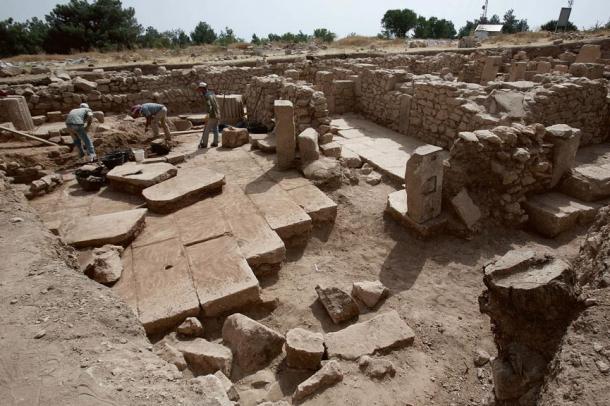
War limits study of Roman Syrian sites, but one has yielded priceless treasures of the past
The war has so disrupted parts of the Near East that scholars have just a few Roman Empire sites to study in what was the Roman province of Syria. But archaeologists are able to work a few sites, including Doliche in what is now Turkey, where they have recently discovered a wonderful floor mosaic with a delicate pattern, houses, alleys and water pipelines that will give them a look into the ancient people’s daily lives.
It is important to study such places because urban centers of this kind have barely been explored, and others, such as Apamea and Cyrrhus, have been destroyed, say researchers from the University of Münster in Germany.
“The situation today at the site of Apamea, one of the most important ancient cities of Syria, is particularly bad,” said archaeologist Englebert Winter the University of Münster’s Asia Minor Research Centre in a press release. “Illicit excavations, clearly visible in satellite imagery, have destroyed the entire urban area. It remains doubtful if research there will ever be possible again. The excavations in Cyrrhus, which had recently been resumed, also had to be stopped due to the current situation.”
Antioch, an ancient city and capital of the Roman province of Syria, is inaccessible because of modern construction. Therefore Doliche is very important. Winter said it will provide new information about the ancient urban culture of northern Syria.
The team of researchers plans to extend excavations from private homes into public areas of the ancient city. They hope to gain insight into the city of Doliche and its residents from the Greek era through the Crusades.

Archaeologists excavate the abbey of St. Solomon at Dülük Baba Tepesi, which is a mountain near Doliche where Romans and later Christians worshiped their various gods. (Photo by the University of Münster)
“The most outstanding discovery of our excavations is a high-quality mosaic floor in a splendid complex of buildings with a court enclosed by columns that originally covered more than 100 square meters [328 square feet],” archaeologist Michael Blömer was quoted as saying in the press release. “Because of its size and the strict, well-composed sequence of delicate geometric patterns, the mosaic is one of the most beautiful examples of late antique mosaic art in the region. These first findings already reveal the potential that the site has for further research into the environment of the urban elites and for questions as to the luxurious furnishing in urban area.”
The researchers are unclear as to the exact purpose of the building in which the mosaic was found but believe it to be the villa of a rich person.
Human habitation at the site of Doliche goes back much further than 2,000 years or so. The team of archaeologists from the University of Münster also has been excavating a nearby overhanging rock shelter that dates from between 600,000 BC to 300,000 BC. People settled there because of the presence of flint, from which they could make stone tools, said Professor Winter. He called the site central to the early history of mankind.

The dig turned up the bronze figurine of a stag dating to the first millennium BC at the mountain of Dülük Baba Tepesi, which neighbors Doliche. (Photo by the University of Münster)
At a related dig, the neighboring mountain of Dülük Baba Tepesi, archaeologists for 15 years have been excavating the sanctuary of Iuppiter Dolichenus (who is not truly the same as Roman Jupiter), which the press release calls one of the most important gods of the Roman Iron Age. The site was used as a temple or sanctuary as far back as the ninth century BC, which makes it much older than researchers initially thought. As confirmation of this, they found a high-quality bronze figure of a stag dating to the first millennium BC. They also have discovered and have been excavating well-preserved parts of a wall enclosing the Roman sanctuary and parts of Christian abbey that was established on the mountaintop after the heathen cult there ended.
Featured image: This delicately elaborate mosaic has been excavated from a possible rich person’s villa in Roman Doliche, one of the few areas in Roman Syria where archaeologists can work. (Photo by the University of Münster)
By: Mark Miller
















Comments
Christians that were there, did Not worship various gods. They worshiped Jehovah God, the father of all creation.. And being in that century, they therefore worshiped Jesus after his ascension :)
Jesus is God ! Thanks..